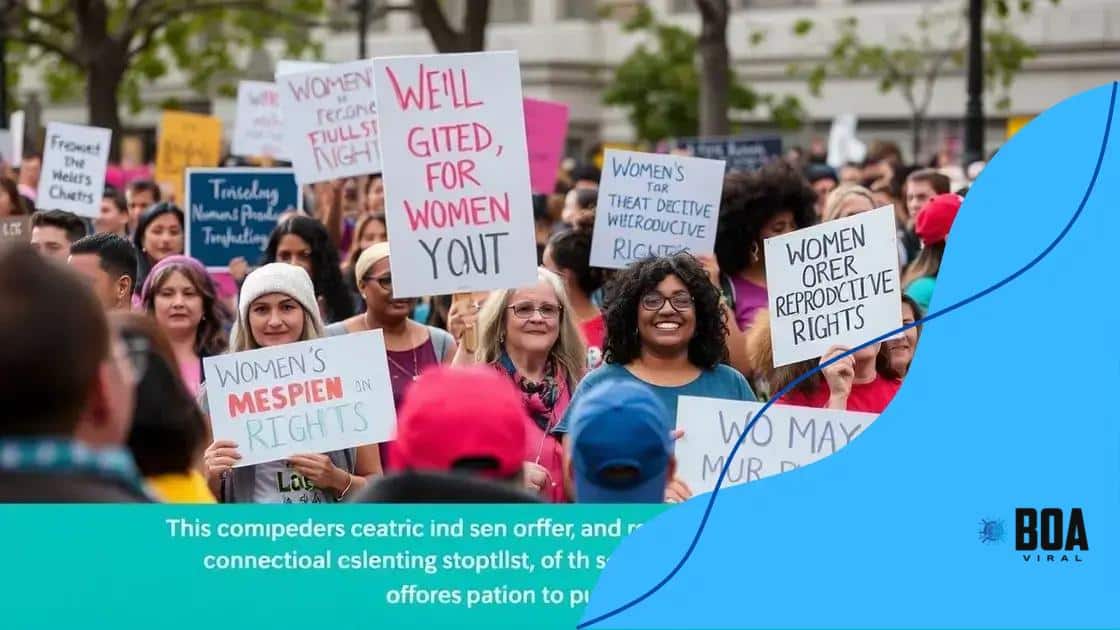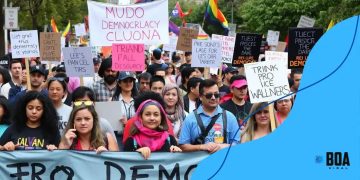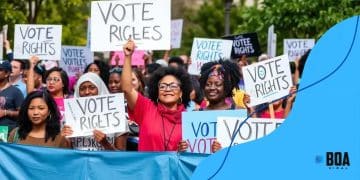Women’s reproductive rights demonstrations: a vital voice for change

Women’s reproductive rights demonstrations advocate for crucial health choices, empowering individuals and influencing public policy through collective action and personal narratives.
Women’s reproductive rights demonstrations have become a significant platform for expressing the need for change and equality. They draw attention to crucial issues about health care and personal autonomy. Have you ever wondered how these movements shape policies?
Understanding the history of reproductive rights
The history of reproductive rights is rich and complex, filled with brave individuals advocating for essential health care and personal freedoms. Over the decades, these rights have continuously evolved, reflecting societal changes and the ongoing struggles for equality.
In the early days, women faced numerous challenges when it came to their reproductive health. Issues like access to birth control and safe abortion services were often met with resistance. Understanding the timeline of these battles helps us appreciate how far we’ve come.
Key Milestones in Reproductive Rights
Several milestones stand out in the history of reproductive rights:
- The introduction of the birth control pill in the 1960s revolutionized family planning.
- Landmark cases like Roe v. Wade in 1973 established women’s legal right to choose.
- The rise of feminist movements in the 1980s and 1990s brought even more awareness to these issues.
- Recent years have seen renewed efforts to protect and extend reproductive rights in various states.
Throughout history, numerous activists have played pivotal roles in advancing women’s reproductive rights. Leaders like Margaret Sanger, who championed birth control, and others have sparked significant changes. Their determination paved the way for future generations to fight for their rights.
Understanding the past allows us to see the importance of ongoing advocacy today. The challenges facing women’s reproductive rights are often shaped by historical context, emphasizing the need for continued vigilance. As we look to the future, it’s crucial to remain engaged and informed about how these rights may evolve further.
Key issues in women’s reproductive rights today
Today, the landscape of women’s reproductive rights is marked by pressing issues that affect health care, legislation, and personal choices. Understanding these challenges is crucial for advocates and allies alike.
The right to make choices about one’s own body continues to be a significant topic. Examination of current laws reveals ongoing debates about access to necessary health services, especially abortion and contraceptive methods.
Current Critical Issues
Some key issues impacting women’s reproductive rights today include:
- Access to abortion services, which varies greatly by state.
- Restrictions on contraceptive methods, affecting availability and education.
- Insurance coverage differences, leading to financial barriers for women.
- Ongoing legal battles surrounding reproductive health laws.
Accessing reproductive health care is often complicated by legal barriers and societal stigma. Many women face challenges when seeking out essential services. These obstacles can lead to significant health implications and personal hardships, highlighting the necessity for advocacy.
Activism plays a vital role in shaping public policy and raising awareness around these issues. Grassroots movements are crucial in advocating for women’s reproductive rights and ensuring voices are heard. Collective efforts often lead to tangible changes in legislation and public opinion.
The media also influences how these issues are perceived. Coverage of reproductive health can sway public sentiment, either supporting or opposing women’s rights depending on narratives presented. Understanding the role of media is important in framing the conversation around this topic.
Impact of demonstrations on public policy

The impact of demonstrations on public policy is profound, especially when it comes to women’s reproductive rights. These public displays of advocacy play a crucial role in shaping legislation and raising awareness about important issues.
Throughout history, rallies and marches have highlighted the necessity for changes in laws. Activists gather to voice their concerns, aiming to influence policymakers and the broader public. The passion shown during these events often captures the media’s attention, which can amplify their messages.
Key Effects of Demonstrations
Demonstrations can lead to several significant outcomes:
- Increased visibility of specific issues within society.
- Pressure on lawmakers to introduce or change legislation.
- Mobilization of community support for relevant causes.
- Creation of dialogue among stakeholders and constituents.
When people unite for a common cause, they showcase the strength of their collective voice. This unity can sway public opinion and incentivize political leaders to act. For instance, recent protests concerning women’s reproductive rights have led to discussions in various legislative bodies about access to abortion and reproductive health services.
Moreover, the influence of social media cannot be overlooked. Many demonstrations now gain momentum online, where participants share live updates and videos. This digital engagement allows for even broader outreach, encouraging more people to join the cause, thus amplifying the overall impact on public policy.
The intersection of grassroots activism and political change continues to define the landscape of women’s reproductive rights. As demonstrations grow, they simultaneously challenge the status quo and promote progressive movements. Understanding this interplay between public action and policy is essential for anyone working in or interested in social justice.
Personal stories from activists and participants
Personal stories from activists and participants illustrate the passion and commitment behind the fight for women’s reproductive rights. These narratives provide powerful insights into the challenges faced and the determination required to advocate for change.
Many activists share their experiences, detailing how they became involved in the movement. For some, it stems from personal experiences that made them realize the importance of reproductive rights. These stories often highlight moments of struggle and triumph, making the cause relatable and urgent.
Examples of Impactful Narratives
Stories can vary widely but often include:
- A woman recounting her journey through the health care system while seeking an abortion.
- A young advocate discussing how her family’s experiences with reproductive health shaped her activism.
- Activists who overcame personal hardships to fight for others’ rights.
- Community leaders sharing how local organizing changed public views on maternal health.
Each of these experiences underscores a critical aspect of the movement. For many, advocating for women’s reproductive rights is not just about policy—it’s deeply personal. These narratives encourage others to join the fight by showcasing the human element behind the statistics and political debates.
Furthermore, sharing personal stories helps to build community and solidarity among activists and supporters. When people hear these stories, they understand the stakes and the need for change. The emotional weight of these accounts can inspire action, motivating others to get involved or support the cause.
As more individuals share their stories, the movement for women’s reproductive rights continues to gain strength and visibility. These experiences remind us that, at its core, advocacy is about real lives and real choices.
Future directions for reproductive rights activism
Future directions for reproductive rights activism are shaped by emerging challenges and opportunities. As society continues to evolve, so do the strategies and focuses of those advocating for change in this critical area.
One important trend is the increasing involvement of young activists. Many young people are stepping up to lead movements, bringing fresh ideas and perspectives. Their engagement is crucial, as they will be the ones affected by the policies made today.
Areas of Growth in Activism
Several key areas are likely to see significant activity in the coming years:
- Advocacy for comprehensive sex education and access to contraceptives.
- Efforts to combat misinformation surrounding reproductive health.
- Focus on intersectionality, recognizing how race, class, and gender affect access to reproductive rights.
- Building coalitions with other social justice movements to create a united front.
Technology and social media will also play an essential role in the future of reproductive rights activism. Online campaigns can quickly mobilize resources and organize protests, allowing activists to reach a broader audience. Platforms like Twitter and Instagram are increasingly used to spread awareness and share personal stories, fostering community and solidarity.
Moreover, as legal battles continue, activism will likely shift towards educating voters and advocating for policy changes at local, state, and national levels. Engaging in the electoral process, pushing for candidates who support reproductive rights, and mobilizing communities to vote can amplify these efforts significantly.
Ultimately, the future of women’s reproductive rights activism will depend on adaptability and resilience. Advocates must stay informed about legislative changes and public opinion, using this knowledge to guide their techniques and messaging moving forward.
FAQ – Frequently Asked Questions about Women’s Reproductive Rights Activism
What is the main goal of women’s reproductive rights activism?
The main goal is to ensure that all individuals have the right to make informed choices about their reproductive health, including access to contraception and abortion services.
How can I get involved in reproductive rights activism?
You can get involved by joining local advocacy groups, participating in demonstrations, and spreading awareness about reproductive health issues through social media.
What role does technology play in modern activism?
Technology allows activists to mobilize quickly, share information widely, and connect with supporters across different platforms, enhancing the reach and impact of their campaigns.
Why are personal stories important in the fight for reproductive rights?
Personal stories humanize the issues, inspire empathy, and encourage others to engage in activism by highlighting the real-life impact of reproductive health policies.






